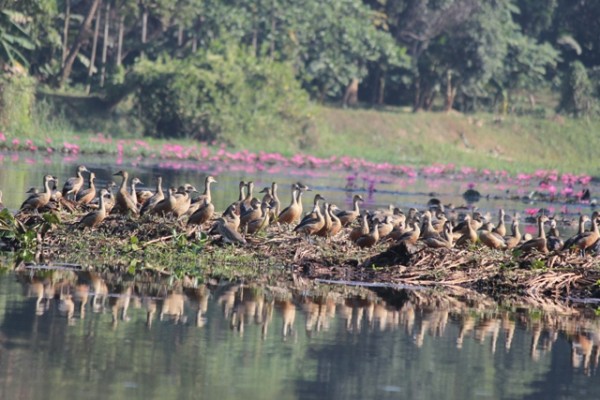Far from the man-made political machinations of the city, and with the advent of the winter season, millions of migratory birds of different species seek the warm marshes, forests, and rivers of Bangladesh. The effect of hosting these millions of beautiful and lively exotic birds in the natural surrounds of Bangladesh rejuvenates the entire country and keeps it in ‘mint condition’, despite encroaches of unenlightened Man.
By Niamat Ullah Sarker*
Bangladesh is an ideal hospitable geographical location to millions of migratory birds with its short duration and very comfortable winter season. Jahangirnagar University, Tangoar Beels, Nijhum Dwip, Chitagong Hill Tracks, Mirpur Zoo, Hakaluki Haor and Hyle Haor, Mirpur Ceramic Lake, Netrokona Haor are some of the best viewing stations for migratory birds.
From early November to late December, the birds visit these areas, coming from far-flung icy lands like the Himalayas, Siberia, Nepal, Xinxian and Mongolian regions to stay until the end of April.
The chirping and fluttering of birds all around the lakes of Jahangirnagar University (JU) are as exclusively beautiful as ever. The evergreen campus echoes with their sounds as thousands of man’s feathered friends have already taken shelter there to have ‘winter holidays’ on the campus.
Around twenty small-to-medium size lakes are in the area, all endowed with blooming red water lilies, with green forested lands adjacent and different species of fishes – forming a place that offers safe havens to wildlife but also are like a sacred place for the migratory birds.
At the very beginning of winter, the birds arrive on campus in search of food and to get rid of the effects of the frosty lands where they came from; the extreme cold weather on the Himalayan and Siberian regions. The birds survive on small fish, insects, small snails and aquatic plants. Every day, huge numbers of visitors and bird-watchers travel there too with a view to charm their eyes. The lakes beside the Jahanara Imam Hall and the lake in front of the administrative building are focal points for bird gatherings and bird watching.
This year, at least 15 species have arrived at the JU campus. Lesser Whistling Teal (Chhota Sarali), Greater Whistling Teal ( Bara Sarali), Cotton Pigmy Goose (Balihansh), Pochard (Bhulihansh), Darters (Snake bird), Pintail Duck, Heron, Comb Duck Gurgani, and Flycatcher are some of the beautiful, in fact quite marvelous birds on campus.
Though the number of migratory birds in the Bangladesh has dramatically decreased due to climate change and other natural phenomenon, apparently, the scene on the JU campus is really different. This year a great number of migratory birds have arrived.
Last year, the number of birds migrating through and to JU was reduced because of rampant poaching, fish farming in the lake and owing to contamination of the waters. This year, the authorities at JU have made special arrangements for the migratory birds. They have cancelled the commercial leases for fish firming in the lakes so that the sanctuary for the birds is ensured. Alsos, a few months ago the authorities caught the bigger fish in the lakes and removed them to ensure that the migratory birds could stay there tranquilly. Above all, the excessive numbers of water lilies have been cleared from the lakes along with other clogging shrubs. This special arrangement does not only increase the beauty of the campus but also attracts ever more birds to the campus.
Some cultural organizations on the JU campus have arranged special programmes to ‘welcome’ the migratory birds. They have organized “Pakhider Jonno Gaan” to that end as well as to spread awareness to the students and residents about the migratory birds which has resulted in the campus becoming a protected sanctuary.
The fort-like red coloured buildings, the evergreen trees, waterlily-decorated lakes, the calm and quiet environment of the Jahangirnagar University have made the campus really a heaven for birds which is now a central attraction for many people, specially for those who reside in the dusty brick lanes of the urban sprawl and city of Dhaka.
*Student, Department of Development Studies, University of Dhaka










